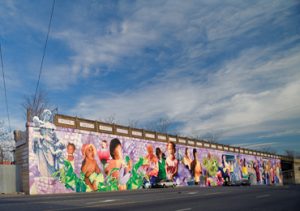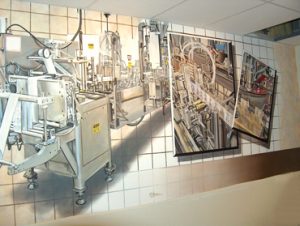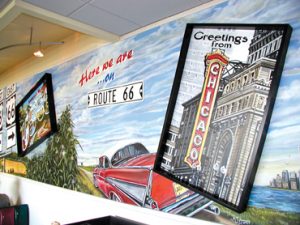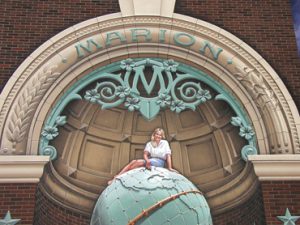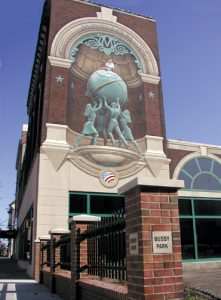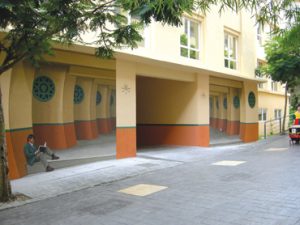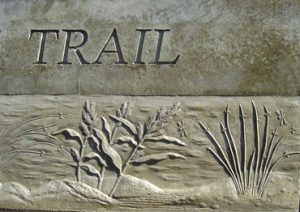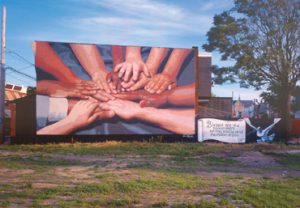Digital Printing
Grand-Format Walls
A cross section of beatiful, bigger-than-life murals
Published
17 years agoon
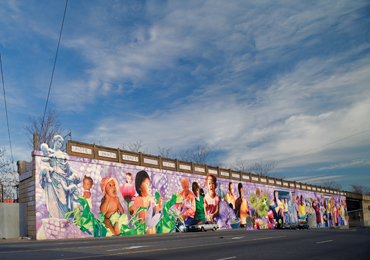
Murals possess an almost cosmic universal power of connection. Whether it’s the 45,000 sq. ft. of murals that adorn Thousand-Buddha Grottoes of Dunhuang City, China (which artisans painted during the 4th through 14th centuries A.D. to depict tribal activities and mystical symbolism); a florid, graphic fresco from Mexican Diego Rivera that depicts the plight of Mexico’s peasantry; an inkjet print that wraps a building with a commercial message or a museum wall embellished with solvent- or UV-printed wallpaper, these massive tableaus captivate and capture onlookers’ imaginations. Several experts offer insights and experiences in rendering these gargantuan creations.
Mark Adamany
Mark Adamany has operated Adamany Art & Design (Rockford, IL), as a one-man shop that emphasizes handpainted mural production, for 12 years. An inspirational talk with his father spurred his entrepreneurial decision.
“I was at a crossroads in my life, pushing 30, playing in a band and working part time as a freelance artist,” Adamany said. “I was looking to settle down, but was having doubts about a career path. My dad told me, ‘If you don’t take a risk and pursue your dream job, you’ll never be happy or successful.’”
AdvertisementHe cites Chuck Close, a photorealistic painter and illustrator who first gained popularity in the 1970s, as an influence. Adamany admires Close’s ability to obtain portrait details “down to pores and pimples” while wielding only a brush and paint.
His first job as his own boss entailed developing a mural for Beef-a-Roo, a Rockford-based, fast-food restaurant that has since grown to nine locations throughout Illinois. The mural depicted a car buff’s dream: a ’57 Chevy Bel Air, an early-’60s-vintage Corvette, and a ’57 Ford Thunderbird lined up facing the restaurant, reminiscent of diners’ glory days.
Since then, he hasn’t looked back. His portfolio includes developing a surreal diorama for the domed roof of Council Bluffs, IA’s Star Cinemas (see ST, February 2004, page 34); a huge, African-themed wall mural for the Kalahari Resort in the Wisconsin Dells (which he has since replicated at another Kalahari resort in Stow, OH); and countless other restaurant and retail environments.
Recently, Adamany created a unique tableau for Rockford-based Anderson Packaging, which produces containers for Procter & Gamble’s Crest and Pfizer Pharmaceuticals products, among others. Initially, Anderson’s company president specified that Adamany develop realistic renderings of the company’s manufacturing apparatus. However, Adamany convinced Anderson that an impressionistic depiction of the company’s equipment would impress prospective clients.
“I developed a ‘metaphorical’ sketch that transformed Anderson’s equipment into an angled or skewed reproduction,” Adamany said. “Once the owner saw my rough sketches, he loved my idea and gave me the go-ahead.”
Advertisement
Adamany’s use of canvas rolls to fabricate his indoor installations has been a significant development. These sometimes provide a more workable surface than a textured wall, and they also allow him to work at home.
“Instead of having to spend eight to 10 weeks on the road – away from my wife and family – I can create the graphics in my studio and go home every night,” he said. “And, I can pass along the savings of not accumulating the hotel, meals and scaffolding costs required if I were onsite for the entire process.”
Predictably, the advent of digital-mural fabrication has encroached on his business. He sees pros and cons to each decoration method – an inkjet-printed mural “may be good for quick-turnaround jobs. But, if the client has the budget for a handpainted mural, a digital print can’t touch the character, depth and texture of handpainted work.”
Eric Grohe
Eric Grohe grew up with a keen appreciation for art – his father, Glenn Grohe, was a famous illustrator whose work appeared in hundreds of national magazines such as the Saturday Evening Post, Collier’s and Field and Stream. In 1961, Eric later worked stints as a graphic designer for an architectural firm and as a dig illustrator for Cambridge University’s archaeology department.
AdvertisementA pivotal event occurred in 1973, when he was hired to design environmental graphics for Expo ’74, the World’s Fair that took place Spokane, WA. After this job, civic and corporate entities hired him to create artwork for public spaces. These projects gradually enlarged, and Grohe grew into a career of devising mega-format murals and trompe l’oeil.
“My first mural seemed out of place,” he recalled. “It was for a public facility on the West Coast, and it was in a controlled-lighting environment. When I stepped back and looked at it when I finished, I realized I hadn’t done a good job of taking its surroundings into account. That day, I leaned that a mural isn’t just a large painting; it’s an architectural component.”
When contacted, Grohe begins the process by asking the prospective client for photos of the building or space in question in the context of its larger neighborhood. If they aren’t available, he’ll explore Google Earth to observe local architecture and deduce how the sun would illuminate the mural throughout the year. After Grohe has considered these factors, he’ll address the client’s philosophical approach to the project.
“I think murals should have a sociological meaning,” Grohe said. “I believe they should speak to the nobler side of human nature and provide a sense of history that can greatly enrich a project. Sometimes, I have to persuade a client to raise his sights.”
When a building in downtown Marion, OH was razed for a new city park, it exposed a prominent building’s unsightly wall. The building’s owner asked Grohe to transform that side of the structure into a landmark that referenced local history.
Grohe began his restoration process by having the 2,510-sq.-ft. surface replastered with Keim Universal Render. On this new surface, he applied three coats of Keim’s mineral-based paint; Grohe prefers mineral-based media because they offer strong durability and won’t fade in outdoor environments.
For the wall’s large niche, he fashioned four characters that represent the community’s pillars – pioneers, agriculture, industry and education. These figures support a globe, which, in his design represents the future; and a girl, who represents the present; atop the globe, they point to Marion’s location, which represents the future. Along the wall’s length, he painted medallions and bas-relief “sculptures” that depict Marion’s significant events and historical figures.
Grohe’s talent and reputation landed an unusual opportunity this past summer. For three weeks, he taught a mural-design course at a middle school in Kuala Lampur, Malaysia. Grohe’s curriculum included perspective drawing and the fundamental of mural design and execution. He and his students drafted and painted a demonstration mural that he’d previously designed. Though he laments the short duration, he came away impressed.
“Their educational program was very thorough in all subjects,” Grohe said. “And the amount of resources devoted to art education was impressive. In the United States, it’s often the first thing to go in a school’s budget, which is unfortunate, because art inspires imagination and creative thinking.”
Linda Patterson
Linda Patterson, a Newark, CA-based artist with an affinity for depicting natural scenery, develops her murals in an unusual medium: Concrete. Patterson, who holds an MFA from San Francisco State University, has worked in traditional media, such as oil painting and illustration, and especially enjoys depicting animals in their habitats – particularly wetland environments.
Upon exploring new media to convey such imagery in the late 1990s, she discovered a formed-concrete process that dramatically conveyed her preferred subjects. After Patterson has sculpted her images in clay, molds are made to hold the images. Scott Systems Inc. (Denver) created elastomeric flex-liner® form liners that were sent to the trail site where installers cast the concrete to create murals on retaining walls. After the liners were pulled away, the art template remains indelibly formed in concrete. Patterson’s textured, bas-relief sculptures are repeated side-by-side and extend more than a half mile at eight underpasses along the trail. After the form liners are cut away, the template remains indelibly formed in concrete.
“The molding process captures an image down to fine details,” she said. “The texture and detail attained remind me of cast-bronze artwork.”
For her most recent mural project, Patterson fashioned concrete nature-scapes that span half a mile of the San Tomas Aquino/Saratoga Creek Trail, which offers Santa Clara, CA residents and workers – many of whom ply their trade in the region’s Fortune 500 Silicon Valley firms, such as Intel, Yahoo and Apple – a 12.8-mile green-space amidst the area’s burgeoning development. It also connects to the San Francisco Bay Trail.
Patterson began with hand sketches of the diverse, local flora and fauna, such as Western burrowing owls, pond turtles, trees and plants that surround the trail’s creek.
She said, “Holding a pencil to paper onsite seems more natural than holding a mouse, sitting at the computer in my studio. It’s a more direct process that’s more closely connected to the subject matter for a site-specific project.”
Patterson developed 15, 12-ft.-long scenes that range in height from 2.5 to 6.5 ft. As with any public-space project, the job entailed working with a large consortium of public and private interests. Her work for the $22 million project required approval from Santa Clara’s Cultural Advisory Commission and civil, structural and geotechnical engineers, among others. A landscape architect and an environmental planner assisted her work.
“It’s such an intimate, comfortable environment,” Patterson said. “It passes under freeways and near congested areas, but it feels isolated from the noise and bustle outside. The mural helps underscore its tranquility in an attractive, yet unobtrusive, manner.”
To provide a visual and tactile experience, she sculpted the birds, plants and animals at actual size at 1.5-in. relief, which reveals fine texture. Patterson said the murals tell a story about varied ecosystems and their influence on the natural world.
Publicly funded murals
The plight of the metaphorical animal depicted in Los Lobos’ song “Will the Wolf Survive?” parallels the struggle that often plagues public-art projects and the entities that support them. They compete against other interests (often with greater wherewithal) and are regarded with apathy (if not antipathy) by large segments of the population.
However, in some places, murals that embellish urban landscapes have been rediscovered as a means of cultural enrichment and flourish. Philadelphia’s city government established the Mural Arts Program (MAP) in 1984. Brian Campbell, the assistant to Program Director Jane Golden, said the program has helped unify previously fractured communities.
“Some areas of town have suffered a decline in population and subsequent urban blight,” he said. “Sometimes, a shift in a neighborhood’s ethnic makeup has triggered racial discord. Not only do these murals beautify the community, but they require cooperation and consensus to develop and approve the content. This has helped people in these communities talk and understand one another’s viewpoints.”
Fishtown, a neighborhood on the city’s north side long inhabited by Irish Catholics, has been transformed by diverse populations. After officials approved MAP’s proposed mural, which Philadelphia artist Cesar Viveros designed and painted as an allegory of young people’s difficult choices, some neighborhood opposition arose.
“There were those who feared that it would be a ‘wailing wall’ for drug use,” Campbell said. “We agreed to more community meetings, and people talked out their differences. Once people felt, heard and understood the mural’s purpose, the perception changed, and support was almost unanimous.”
The program operates on a $5 million annual budget – Philadelphia’s budget appropriates roughly 17% of this sum, and grants and charitable contributions comprise the remainder. In addition to commissioning professional muralists, MAP undertakes art-education programs for students of all ages within the city’s school system. All told, he said the program undertakes 150 to 160 projects annually.
The Regional Arts and Culture Council (RACC), which has served the greater Portland, OR, area since it became a 501(c) (3) organization in 1985, assumes local mural projects under its umbrella. With an overall budget of roughly $4 million, RACC serves Clackamas, Multnomah and Washington counties through its grant and public-art programs, as well as education and advocacy efforts. Peggy Kendellen, RACC’s public-art manager, said the city earmarks $50,000 of RACC’s budget for murals.
To receive RACC approval and funding, Kendellen said a mural must fulfill three criteria: artistic merit, concept and execution; community support; and an artist’s demonstrated ability to complete a mural on time and within budget.
RACC marshaled funds to underwrite a mural that decorates the front wall of the School and Community Reuse Action Project (SCRAP), an organization that collects surplus or torn-down building and construction materials and resells them inexpensively. SCRAP also conducts programs that teach students the value of conservation.
Bruce Orr, a multimedia artist, coordinated the painting of the 17 3 42-ft. mural, which he and a team of dozens of volunteers painted using Nova Color artists’ acrylics and a clear-acrylic topcoat. He initially grid his pattern with chalklines and outlined the template in gray. The mural depicts people cooking, writing, sewing and undertaking various “creative” tasks.
“I think the word ‘creative’ is often overused and misused, such as in discussions of the ‘creative class,’” Orr said. “People in Portland make things, in many shapes and styles, and I wanted to celebrate the character that makes the city special.”
Until recently, Orr wouldn’t have enjoyed the opportunity to devise his mural. In the late ’90s, following a ruling that restricted images of more than 200 sq. ft. within Portland’s city limits, Clear Channel Outdoor convinced Portland’s city council that murals should also be restricted.
Orr said, “It was outrageous to me that the argument that an artistic mural was the same as a Coors Light ad was persuasive.”
After testimony from numerous local artists, and working within the limits of Oregon’s constitution, the council voted in 2004 to exempt all public art from the city’s sign code. Murals are now reviewed by RACC’s public-art advisory committee. N
Companies/Organizations Mentioned
Adamany Art & Design
Rockford, IL
(815) 961-0774
www.adamany.com
Eric Grohe Murals
Tulalip, WA
(360) 653-5821
www.ericgrohemurals.com
Patterson Design
Newark, CA
(510) 790-0134
www.lindapattersondesign.com
Philadelphia Mural Arts Program
Philadelphia
(215) 685-0750
Regional Arts & Culture Council
Portland
(503) 823-5111
www.racc.org
SPONSORED VIDEO
Introducing the Sign Industry Podcast
The Sign Industry Podcast is a platform for every sign person out there — from the old-timers who bent neon and hand-lettered boats to those venturing into new technologies — we want to get their stories out for everyone to hear. Come join us and listen to stories, learn tricks or techniques, and get insights of what’s to come. We are the world’s second oldest profession. The folks who started the world’s oldest profession needed a sign.
You may like
Advertisement
Subscribe

Magazine
Get the most important news
and business ideas from Signsofthetimes Magazine.
Advertisement
Most Popular
-

 Tip Sheet1 week ago
Tip Sheet1 week agoAlways Brand Yourself and Wear Fewer Hats — Two of April’s Sign Tips
-

 Ask Signs of the Times2 days ago
Ask Signs of the Times2 days agoWhy Are Signs from Canva so Overloaded and Similar?
-

 Real Deal1 week ago
Real Deal1 week agoA Woman Sign Company Owner Confronts a Sexist Wholesaler
-

 Benchmarks5 days ago
Benchmarks5 days ago6 Sports Venue Signs Deserving a Standing Ovation
-

 Editor's Note2 weeks ago
Editor's Note2 weeks agoWhy We Still Need the Women in Signs Award
-

 Women in Signs1 week ago
Women in Signs1 week ago2024 Women in Signs: Megan Bradley
-

 Photo Gallery7 days ago
Photo Gallery7 days ago21 Larry Albright Plasma Globes, Crackle Tubes and More
-

 Women in Signs1 week ago
Women in Signs1 week ago2024 Women in Signs: Ashley Borell

